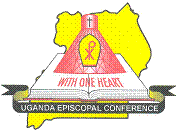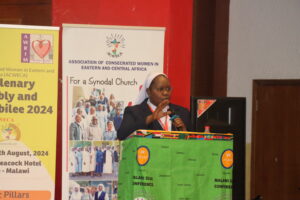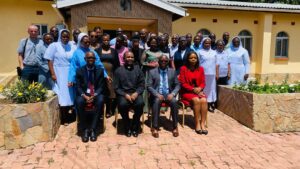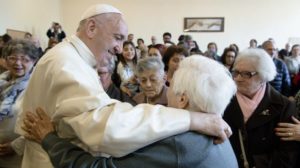UGANDA: The Key Historical Sites of Christian Faith to be visited by Pope Francis in the country

The
Holy Father Pope Francis is expected to visit the historical sites of Uganda
during his Apostolic mission that is scheduled from 27 -29 November, 2015; before
his departure to the Central African Republic.
Holy Father Pope Francis is expected to visit the historical sites of Uganda
during his Apostolic mission that is scheduled from 27 -29 November, 2015; before
his departure to the Central African Republic.
These
historical places include:
historical places include:
Munyonyo
Munyonyo
Shrine is the place where the journey of the 22 Catholic Martyrs began before
their martyrdom at Namugongo. It was at Munyonyo where King Mwanga took the
fateful decision to begin putting Christians to death. The blood of Uganda’s
martyrs was shed on the soil around Munyonyo. The first three Christians to
render their lives for Christ’s sake after the King’s decision did so on 26 May
1886 – they were: St. Denis Ssebugwawo, St. Andrew Kaggwa and St. Pontiano
Ngondwe. Their shrine is currently being re-built in preparation for the Papal
visit. It is also a place where in 1886
Saint Charles Lwanga – leader of Christian community in Uganda baptized St.
Kizito, St. Mbaga, St. Gyavira and St. Muggaga.
Shrine is the place where the journey of the 22 Catholic Martyrs began before
their martyrdom at Namugongo. It was at Munyonyo where King Mwanga took the
fateful decision to begin putting Christians to death. The blood of Uganda’s
martyrs was shed on the soil around Munyonyo. The first three Christians to
render their lives for Christ’s sake after the King’s decision did so on 26 May
1886 – they were: St. Denis Ssebugwawo, St. Andrew Kaggwa and St. Pontiano
Ngondwe. Their shrine is currently being re-built in preparation for the Papal
visit. It is also a place where in 1886
Saint Charles Lwanga – leader of Christian community in Uganda baptized St.
Kizito, St. Mbaga, St. Gyavira and St. Muggaga.
Namugongo
All
of the King’s Christian pageboys were captured and they were sentenced from
Munyonyo and put to death at Namugongo (the Kingdom’s designated place for
execution). On 3 June 1886, 32 young men (Anglican and Catholics), pages of the
court of King Mwanga II
of Buganda, were burned to death at Namugongo for their refusal to renounce
Christianity. Annually on 3 June, Christians from Uganda and other parts of the
world congregate at Namugongo to commemorate the lives and religious beliefs of
the Uganda Martyrs. Twenty-two of the Catholic martyrs were canonized by Pope
Paul VI on 18 October 1964 and are regarded as saints in the Catholic Church. A
basilica has been built at the spot where the majority of them were burned to
death. At Namugongo, the Holy Father will celebrate the 50th anniversary of the
canonization of the Uganda Martyrs.
of the King’s Christian pageboys were captured and they were sentenced from
Munyonyo and put to death at Namugongo (the Kingdom’s designated place for
execution). On 3 June 1886, 32 young men (Anglican and Catholics), pages of the
court of King Mwanga II
of Buganda, were burned to death at Namugongo for their refusal to renounce
Christianity. Annually on 3 June, Christians from Uganda and other parts of the
world congregate at Namugongo to commemorate the lives and religious beliefs of
the Uganda Martyrs. Twenty-two of the Catholic martyrs were canonized by Pope
Paul VI on 18 October 1964 and are regarded as saints in the Catholic Church. A
basilica has been built at the spot where the majority of them were burned to
death. At Namugongo, the Holy Father will celebrate the 50th anniversary of the
canonization of the Uganda Martyrs.
Nalukolongo
After
the death of Kabaka Muteesa I in 1884, his successor, Mwanga, at the request of
Joseph Balikuddembe and his companions, invited the missionaries back to
Buganda. The team which came included Mapeera, Pierre Giraud and Bro. Delmas
Amans. They arrived on July 13,1885. The following day, they were given
Nalukolongo as their first preaching site. Mwanga wanted to give them a piece
of land nearer to his palace at Mengo, but the missionaries preferred
Nalukolongo because it was easier for ordinary people to access as opposed to
the heavily guarded area close to the palace. However, during the time of
persecution that followed, Nalukolongo became the crucible of faith a source of
encouragement and spiritual strength for the Christians preparing them for the
highest form of Christian witness and martyrdom. Soon after, the missionaries
at Nalukolongo were also imprisoned and eventually expelled from the country in
1888 by the Muslim supporters of King Kalema.
the death of Kabaka Muteesa I in 1884, his successor, Mwanga, at the request of
Joseph Balikuddembe and his companions, invited the missionaries back to
Buganda. The team which came included Mapeera, Pierre Giraud and Bro. Delmas
Amans. They arrived on July 13,1885. The following day, they were given
Nalukolongo as their first preaching site. Mwanga wanted to give them a piece
of land nearer to his palace at Mengo, but the missionaries preferred
Nalukolongo because it was easier for ordinary people to access as opposed to
the heavily guarded area close to the palace. However, during the time of
persecution that followed, Nalukolongo became the crucible of faith a source of
encouragement and spiritual strength for the Christians preparing them for the
highest form of Christian witness and martyrdom. Soon after, the missionaries
at Nalukolongo were also imprisoned and eventually expelled from the country in
1888 by the Muslim supporters of King Kalema.
The
idea of developing it into an elderly and disabled people’s home was conceived
by the Late Emmanuel Cardinal Nsubuga after his residence at Rubaga was crammed
with people seeking food, clothing and shelter. In 1978 Cardinal Nsubuga
decided to turn the place into a home for the needy (Bakateyamba). He
constructed a hostel with a capacity of 300 people. This home began with 10
disabled people. Currently it houses many vulnerable people regardless of their
faith and belief who are being looked after by eight sisters of the Good
Samaritans Order. It was Pope Francis’ request that a home for the destitute be
included on his itinerary in Uganda. And thus, Mapeera Bakateyamba’s home at
Nalukolongo will host the pope at 5:00pm on Saturday November 29, 2015.
idea of developing it into an elderly and disabled people’s home was conceived
by the Late Emmanuel Cardinal Nsubuga after his residence at Rubaga was crammed
with people seeking food, clothing and shelter. In 1978 Cardinal Nsubuga
decided to turn the place into a home for the needy (Bakateyamba). He
constructed a hostel with a capacity of 300 people. This home began with 10
disabled people. Currently it houses many vulnerable people regardless of their
faith and belief who are being looked after by eight sisters of the Good
Samaritans Order. It was Pope Francis’ request that a home for the destitute be
included on his itinerary in Uganda. And thus, Mapeera Bakateyamba’s home at
Nalukolongo will host the pope at 5:00pm on Saturday November 29, 2015.
Rubaga
Saint
Mary’s Cathedral Rubaga, commonly referred to as Rubaga Cathedral, is the
parent cathedral of the Roman Catholic Archdiocese of Kampala, the oldest Roman
Catholic diocese in Uganda. It is the home church of Archbishop of Kampala.
Kabaka Mutesa I Mukaabya Walugembe, the 30th Kabaka of Buganda, who reigned
from 1856 until 1884, once maintained a palace on Lubaga Hill. When fire
destroyed the palace, he abandoned the hill and relocated to Mengo Hill. In
1889, his son Mwanga II of Buganda, donated that land to the French Catholic
missionaries (White Fathers) who were setting up the nascent Catholic church in
the country, at that time.
Mary’s Cathedral Rubaga, commonly referred to as Rubaga Cathedral, is the
parent cathedral of the Roman Catholic Archdiocese of Kampala, the oldest Roman
Catholic diocese in Uganda. It is the home church of Archbishop of Kampala.
Kabaka Mutesa I Mukaabya Walugembe, the 30th Kabaka of Buganda, who reigned
from 1856 until 1884, once maintained a palace on Lubaga Hill. When fire
destroyed the palace, he abandoned the hill and relocated to Mengo Hill. In
1889, his son Mwanga II of Buganda, donated that land to the French Catholic
missionaries (White Fathers) who were setting up the nascent Catholic church in
the country, at that time.
In
1914 the missionaries began constructing a modern cathedral at Lubaga (Rubaga).
Construction was completed in 1925 and St. Mary’s Cathedral Rubaga was
consecrated on 31 December 1925. At Rubaga, Pope Francis will meet with the
Bishops at Archbishop Lwanga’s residence before holding a meeting with the
priests, religious men and women and seminarians.
1914 the missionaries began constructing a modern cathedral at Lubaga (Rubaga).
Construction was completed in 1925 and St. Mary’s Cathedral Rubaga was
consecrated on 31 December 1925. At Rubaga, Pope Francis will meet with the
Bishops at Archbishop Lwanga’s residence before holding a meeting with the
priests, religious men and women and seminarians.
SOURCE:
New Contact; an electronic news publication of the Uganda Episcopal Conference


